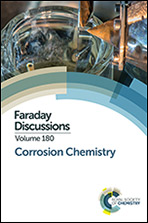Multiphysics modelling, quantum chemistry and risk analysis for corrosion inhibitor design and lifetime prediction
Abstract
Organic corrosion inhibitors can provide an effective means to extend the life of equipment in aggressive environments, decrease the environmental, economic, health and safety risks associated with corrosion failures and enable the use of low cost steels in place of corrosion resistant alloys. To guide the construction of advanced models for the design and optimization of the chemical composition of organic inhibitors, and to develop predictive tools for inhibitor performance as a function of alloy and environment, a multiphysics model has been constructed following Staehle's principles of “domains and microprocesses”. The multiphysics framework provides a way for science-based modelling of the various phenomena that impact inhibitor efficiency, including chemical thermodynamics and speciation, oil/water partitioning, effect of the inhibitor on multiphase flow, surface adsorption and self-assembled monolayer formation, and the effect of the inhibitor on cathodic and anodic reaction pathways. The fundamental tools required to solve the resulting modelling from a first-principles perspective are also described. Quantification of uncertainty is significant to the development of lifetime prediction models, due to their application for risk management. We therefore also discuss how uncertainty analysis can be coupled with the first-principles approach laid out in this paper.
- This article is part of the themed collection: Corrosion Chemistry

 Please wait while we load your content...
Please wait while we load your content...